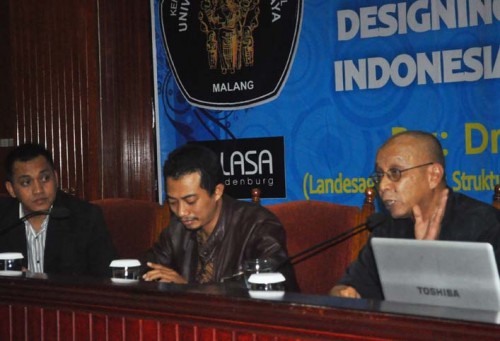Improve the Design of Indonesia’s Electoral System
Prasetya Online, 16 September 2011
http://prasetya.ub.ac.id/berita/Improve-the-Design-of-Indonesias-Electoral-System-5943-en.html
In every General Election (Pemilu), Indonesia always makes a new electoral system Act (UU). During the reform era only, it has born two Acts, namely electoral system Act No. 2003 and 2008. In both Acts, for the election of the members of the House of Representatives of the Republic of Indonesia (DPR RI), for example, it contained several goals that turned out to be violated in practice. Some of these goals include proportionality, accountability, a high degree of representation as well as simple multi-parties. Dr. Pipit Kartawidjaja from Landesagentur fuer Arbeit und Structure (LASA) Brandenburg GmbH Germany conveyed this in a guest lecturing organized by Political Science Faculty of Social Sciences (FISIP) on Thursday (15/9).
Based on his experience in escorting elections in various countries including Indonesia, Pipit underlined the need of improving and monitoring of its implementation. “Electoral system does not need to be changed each time it is done. It just needs to be improved and monitored. This is also done by Germany and other countries”, he said. Toward that improvement, Pipit departed from the technical elements which he called the electoral system like the contestant nomination, voting votes, electoral location division, calculation and execution.
Dr. Pipit Kartawidjaja (right) and M. Faishal Aminuddin (middle)
discuss the evaluation of Indonesia electoral system designOf the five technical devices, the division of electoral location, according to him is the most important electoral system. This point also has in common with the majority system (district) in United States. “Although Indonesia proportional electoral system is different with a majority election (district) of United States, both have the same devices,” said an alumni of Institut Teknologi Bandung (ITB). Both, in Indonesia and United States, every province or state has the right to send their representatives to parliament.
Based on the result of the election observation in Indonesia in 1999, 2004 and 2009, he noted the criteria of distribution of seats are not clear. For example in 2004, he noted that Nanggroe Aceh Darussalam (NAD), Sumatra Utara, Sumatra Selatan, Maluku, Lampung and Nusa Tenggara Barat (NTB) as a defect and corrupt the chairs. Based on population, for 3 consecutive periods, Jawa Barat, Jawa Timur, and Jawa Tengah, seat on the highest number of seats. In 2009, for example, Jawa Barat is 91 seats, Jawa Timur (87) and Jawa Tengah (77).
Based on the same electoral location/district, Pipit analyzed the number of seats with some parameters like threshold veiled/mathematical, even-odd electoral districts, electoral district layers and how to count. On under cover verge, the number of seats decreased in a electoral district, it also decreased in the minor political parties (gurem party) to get a seat or a growing number of seats in a more proportional electoral district. In addition, he also stated that if the amount of small electoral districts and the number of seats numbered from even the political parties tended to favor the second rank. Conversely, if the amount of small electoral districts and the chairs number is odd, then it will benefit the party who gets the most votes. This, according to him, it will shrink if the number electoral district higher. “The argument is valid only if there are only two contestants are competing and the distance between the winners and losers is not much different. Although not a standard argument, but the argument is very useful in election observation,” said a man from Kediri.
Simple multi-parties
“Election 1999 resulted simpler multi-parties system than the 2004 and 2009”, said Pipit. Rated as a simple multi-parties system, in 1999 recorded 21 political parties (ENPP 4.72) sitting in Parliament where the two of them controled more than 50 percent of seats vote. While in 2004 and 2009, respectively 16 (ENPP 7:07) and 9 (ENPP 6:21) political parties sitting in Parliament where the three largest accounts for more than 50 percent of the seats. Beyond the threshold and scale shrinking electoral districts, simplification of the party system in presidensialisme system can be reached, among others through the House with the election simultaneity election (apart from the area), togetherness of presidential ballot papers and political parties, election threshold is lowered, how to count votes, moves co-optation Parliament president and the House structure.
“The number of real political parties in parliament are not sufficiently explain the multi-parties system”, he explained. Each definition, according to him, the system of political parties also include the ability to coalesce and perform the function of suppressor/bully, the effective number of political parties, the index fragmentation and volatility.
Indonesia’s election is still problematic
“Post-authoritarianism, it shows a political organization that does not appear with ideological character and work on the basis of clear rules of organization”, said M. Faisal Aminuddin, a lecturer of FISIP UB, exposed the problematic of electoral system in Indonesia. In addition, other problematics that appear are the pressure of political success lies in the sheer luxury of the material, political elites tend to be exclusive and maintain patron-clientilism, the creation of political castes and class in the selection of a power structure based on bloodlines and money as well as instant public voting. Assessment of electoral system, according to him, it considers the accountability of several indicators, the degree of representation, fair treatment, equal rights of each voter, the balance of the nature of locality, reliable and precise numerical conversion. [nok]








